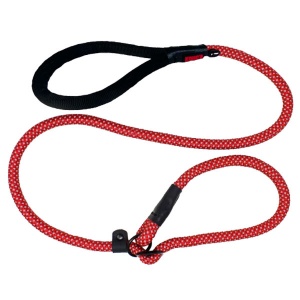Choke Chains: Why they won’t stop your dog pulling on the lead
Quite often people ask how they can stop their dog pulling on the lead. They often go on to explain that they have tried everything, including choke chains. Oh no ![]() Why are these things so readily available and so commonly suggested to anyone with a dog that pulls?
Why are these things so readily available and so commonly suggested to anyone with a dog that pulls?
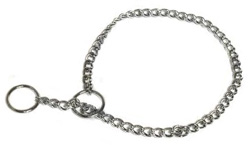 A choke chain or choke collar is a continuous loop (not necessarily always chain, they can be rope or similar) that slips through itself to form a collar at one end (think noose). It is placed high up on the dog’s neck, behind the ears. When the dog pulls they literally get choked by the chain or loop around their neck. Choke chains/collars can also be called slip chains/collars, check chains/collars or correction chains/collars.
A choke chain or choke collar is a continuous loop (not necessarily always chain, they can be rope or similar) that slips through itself to form a collar at one end (think noose). It is placed high up on the dog’s neck, behind the ears. When the dog pulls they literally get choked by the chain or loop around their neck. Choke chains/collars can also be called slip chains/collars, check chains/collars or correction chains/collars.
Why the different names?
Dog trainers often refer to them as correction or check chains/collars and many trainers use them for brief corrections during training. They were not invented for walking your dog and shouldn’t be used for this purpose, even if you agree with the use of the device during other aspects of dog training. If you do walk your dog on one then you are almost guaranteed to choke them.
I wish I knew why they are so often recommended to someone who says their dog pulls on the lead. They were not invented for that purpose and should not be used for that purpose.
Variations of the choke collar
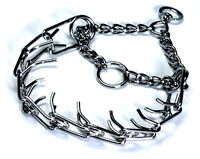 The prong collar is similar to the above but its closure is limited and there are metal prongs turned into the dog’s neck. The idea is to apply pressure to the sensitive part of the dog’s neck rather than to cause the animal to choke.
The prong collar is similar to the above but its closure is limited and there are metal prongs turned into the dog’s neck. The idea is to apply pressure to the sensitive part of the dog’s neck rather than to cause the animal to choke.
Half check collars (also known as combi or Martingale collars) are supposed to only close to the extent that a standard flat collar would close around the dog’s neck. As long as the correct size is purchased so that the two sides of the collar (the rings) meet with a 2 finger gap like a normal collar, these are relatively safe when used correctly and are sometimes used by owners of dogs with narrow heads.
What are check chains used for?
As mentioned above, they have been used for many years by dog trainers who use quick corrections during training sessions. But as also mentioned, worryingly they are often purchased and used by the public to walk their dog and try to stop their dog from pulling on the lead.
Will a check collar stop my dog pulling on the lead?
No. They really weren’t invented for that purpose at all.
Are choke chains harmful to dogs?
Yes. Being choked or strangled is not going to be good for anyone, including dogs. The Association of Pet Dog Trainers (A.P.D.T) produced a leaflet called Let’s Teach Them, Not Choke Them.
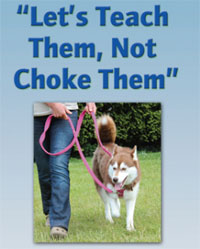 The leaflet explains that choke chains:
The leaflet explains that choke chains:
- Damage dogs
- Cause pain
- Can cause behavioural problems
It further explains that choke chains have been directly linked to the following medical conditions:
- Injured ocular (eye) blood vessels
- Tracheal and oesophageal damage
- Severely sprained necks
- Fainting
- Transient foreleg paralysis
- Laryngeal nerve paralysis
- Hind leg ataxia
What are the alternatives to choke chains?
You need to deal with the reasons why your dog is pulling on lead, try some positive training techniques or purchase an appropriate piece of non-pulling equipment like a non-pull harness or halter. There is no need to hurt your dog in the name of training.
I personally love a front and back D-ring dog harness. They reduce pulling by hindering forward movement and they really do put you in control of the walk without any harm to your dog. My favourite is the Red Dingo Padded Dog Harness. Team it with a Double-Ended Multipurpose Dog Lead and start enjoying walks again. Woof!
Before you buy a choke/check chain
Ask yourself:
- Do I understand what this device should be used for?
- Do I know how to fit and use this device correctly?
- Do I want to risk causing my dog fear, pain or injury?
If you answer ‘no’ to even one of those questions then please step away from the choke chains. Don’t buy one and if you already have one – bin it.
I know what I am doing
If you have received advice and detailed instruction from a professional dog trainer and you are sure you understand how to safely use these pieces of equipment, go for a nylon slip lead which can also double up as a halter-type head collar.
Used correctly, a slip-lead is a useful piece of dog training equipment. It can be used around the dog's neck for brief, soft corrections or, in our opinion the much better option, it can be additionally looped around the dog's muzzle and used as a halter for dog's who pull on lead or to achieve close on-lead control when training.
If using a slip lead only around the dog's neck, it must always be used in a controlled, quick and gentle way. Never harm or be negative towards your dog. Looping additionally around the dog's muzzle, as discussed above, is safer and still effective.
By Jenny Prevel
© D for Dog www.dfordog.co.uk
This article belongs strictly to D for Dog and we do not authorise the copying of all or any part of it.

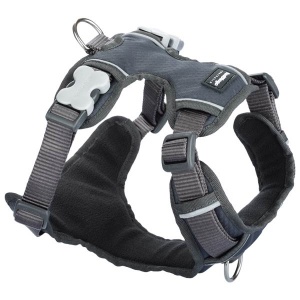
.jpg)
.jpg)
.jpg)
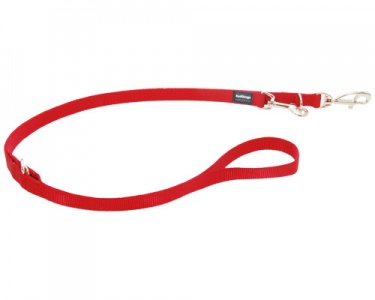
.jpg)
.jpg)
